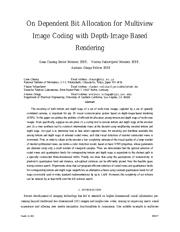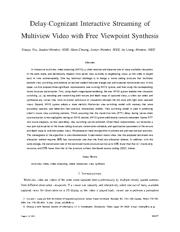A copy of this work was available on the public web and has been preserved in the Wayback Machine. The capture dates from 2019; you can also visit the original URL.
The file type is application/pdf.
Filters
An Overview of Emerging Technologies for High Efficiency 3D Video Coding
[article]
2015
arXiv
pre-print
This paper reviews the recent progress of the coding technologies for multiview video (MVV) and free view-point video (FVV) which is represented by MVV and depth maps. ...
We further introduce the joint coding technologies for MVV and depth maps and evaluate the rate-distortion performance of them. ...
In [32] , Liu et al. proposed a frame-level view synthesis distortion estimation algorithm and designed the bit allocation algorithm based on the rate distortion model of 3D video coding. ...
arXiv:1512.08854v1
fatcat:ooo2efqpcbfatcvnyruv5xagg4
A Novel Rate Control Technique for Multiview Video Plus Depth Based 3D Video Coding
2011
IEEE transactions on broadcasting
This paper presents a novel rate control technique for multiview video plus depth (MVD) based 3D video coding. ...
The joint rate control algorithm is performed on three levels, namely view level, video/ depth level and frame level. ...
, Philips for providing the 3D sequence of Mobile and Nagoya University for providing the 3D video sequence of Kendo. ...
doi:10.1109/tbc.2011.2105652
fatcat:6r3wkq7iqjgovotkvscacxy65u
On Dependent Bit Allocation for Multiview Image Coding With Depth-Image-Based Rendering
2011
IEEE Transactions on Image Processing
Then, we demonstrate that the optimal selection of coded views and quantization levels for corresponding texture and depth maps is equivalent to the shortest path in a specially constructed three-dimensional ...
Our goal is to determine how to best select captured views for encoding and distribute available bits among texture and depth maps of selected coded views, such that visual distortion of desired constructed ...
Motion / Disparity Compensation Coding Tools and DIBR View Synthesis Tools For efficient representation of multiview images and video, novel coding tools and frame structures for texture map encoding ...
doi:10.1109/tip.2011.2158230
pmid:21632301
fatcat:yovdt6eig5gfxoijsdhfdfjdye
Reference frame selection for loss-resilient texture & depth map coding in multiview video conferencing
2012
2012 19th IEEE International Conference on Image Processing
In particular, we construct a recursive model to estimate the distortion in synthesized view due to errors in both texture and depth maps, and formulate a rate-distortion optimization problem to select ...
In this paper, we optimize transmission of multiview video in texture-plus-depth format over a lossy channel for free viewpoint synthesis at decoder. ...
A frame-level distortion model for multiview video transmission is proposed in [9] . ...
doi:10.1109/icip.2012.6467194
dblp:conf/icip/MacchiavelloDHCT12
fatcat:yqdazjeierbvzhxotpjb5yioki
The effects of multiview depth video compression on multiview rendering
2009
Signal processing. Image communication
This article investigates the interaction between different techniques for depth compression and view synthesis rendering with multiview video plus scene depth data. ...
The results show that-although its rate-distortion (R-D) performance is worse-platelet-based depth coding outperforms H.264, due to improved sharp edge preservation. ...
We would like to thank the Interactive Visual Media Group of Microsoft Research for providing the ''Ballet'' and ''Breakdancers'' data sets. ...
doi:10.1016/j.image.2008.10.010
fatcat:ug23i3pjovhwvcnjxe3g7js7ca
Reference frame selection for loss-resilient depth map coding in multiview video conferencing
2012
Visual Information Processing and Communication III
Multiview video in "texture-plus-depth" format enables decoder to synthesize freely chosen intermediate views for enhanced visual experience. ...
Keywords: Multiview video, depth-image-based rendering, loss resiliency * Depth maps can be estimated from texture maps using stereo matching algorithms, or captured explicitly using time-of-flight cameras ...
Using the flexibility of RFS in H.264 to control error propagation in motion compensated frames have been previously studied for single-view video at the frame level. 8 Our contribution in this paper ...
doi:10.1117/12.909462
dblp:conf/vipc/MacchiavelloDHC12
fatcat:scodmsec55b5rguooj52c5236e
A Novel Rate-Distortion Method in 3D Video Capturing in the Context of High Efficiency Video Coding (HEVC) in Intelligent Communications
[chapter]
2013
IFIP Advances in Information and Communication Technology
A Multi-view Video Coding scheme based upon the estimation of correlated parameter sets of elastic models between views is wherein adopted. ...
Prediction, minimization of a rate-distortion Lagrangian cost, directional orientations for intra-picture prediction etc. ...
Motion Compensation Using Higher Order Models and Rate-Distortion Control Higher order motion models and view synthesis techniques are currently investigated in the literature for sub-pixel motion compensation ...
doi:10.1007/978-3-642-41142-7_47
fatcat:q72cl4z46zfytevm6qubdpmwha
Delay-Cognizant Interactive Streaming of Multiview Video With Free Viewpoint Synthesis
2012
IEEE transactions on multimedia
Index Terms multiview video, video streaming, media interaction, view synthesis ...
One key technical challenge is to design a frame coding structure that facilitates periodic view-switching, and achieves an optimal tradeoff between storage cost and expected transmission rate. ...
Based on the experiments on a large number of multiview video sequences, we adopt the modified linear R-D model for H.263 in [28] , where the rate R of a coded frame is modeled as R(QP ) = X/QP + L. ...
doi:10.1109/tmm.2012.2191267
fatcat:t7xc723yzzgv5hheffoakrkifq
Depth map distortion analysis for view rendering and depth coding
2009
2009 16th IEEE International Conference on Image Processing (ICIP)
Index Terms-Multiview plus depth (MVD), depth coding, view synthesis, rate-distortion optimization ...
Video representations that support view synthesis based on depth maps, such as multiview plus depth (MVD), have been recently proposed, raising interest in efficient tools for depth map coding. ...
Note that modern video encoders, e.g., those based on H.264/AVC [11] make extensive use of rate-distortion characteristics for mode decision, rate control, etc., thus using such a coder to encode a sequence ...
doi:10.1109/icip.2009.5414304
dblp:conf/icip/KimOLTG09
fatcat:oo2tzi3kozdivc47by42resrii
Stereoscopic Visual Attention-Based Regional Bit Allocation Optimization for Multiview Video Coding
2010
EURASIP Journal on Advances in Signal Processing
We propose a Stereoscopic Visual Attention-(SVA-) based regional bit allocation optimization for Multiview Video Coding (MVC) by the exploiting visual redundancies from human perceptions. ...
Finally, by using the extracted SVA-based ROIs, a regional bit allocation optimization scheme is presented to allocate more bits on SVA-based ROIs for high image quality and fewer bits on background regions ...
Acknowledgments The Interactive Visual Media Group at Microsoft Research, HHI, and Nagoya University have kindly provided The authors with multiview video sequences and depth maps. ...
doi:10.1155/2010/848713
fatcat:cl5nl7u7efbefbwjsk4j5ius6e
Optimal Lagrange Multipliers for Dependent Rate Allocation in Video Coding
[article]
2016
arXiv
pre-print
In extensive monoview and multiview video coding experiments, we show that our DP algorithm and selection of optimal multipliers on average outperform comparable rate control solutions used in video compression ...
In a typical video rate allocation problem, the objective is to optimally distribute a source rate budget among a set of (in)dependently coded data units to minimize the total distortion of all units. ...
For multiview, assuming independently coded units, [17] considered a uniform rate allocation among views in a multiview video system, and proposed a DP-based algorithm to select the views for encoding ...
arXiv:1603.06123v1
fatcat:cu5qojzrurgwracqi76z4te6v4
Loss-Resilient Coding of Texture and Depth for Free-Viewpoint Video Conferencing
2014
IEEE transactions on multimedia
Further, synthesized view distortion sensitivities to texture versus depth errors are analyzed, so that relative importance of texture and depth code blocks can be computed for system-wide RPS optimization ...
Finally, quantization parameter (QP) is adaptively selected per frame, optimally trading off source distortion due to compression with channel distortion due to potential packet losses. ...
Contribution over Our Previous Work In [40] , a similar scheme to minimize expected synthesized view distortion based on selection of reference frame at the block level was proposed for depth maps only ...
doi:10.1109/tmm.2014.2299768
fatcat:mjezqtibwnfjdoopez7hm7xpla
Rate-Distortion Analysis of Multiview Coding in a DIBR Framework
[article]
2012
arXiv
pre-print
Depth image based rendering techniques for multiview applications have been recently introduced for efficient view generation at arbitrary camera positions. ...
We adopt a rate-distortion framework based on a simplified model of depth and texture images. Our model preserves the main features of depth and texture images. ...
RD Optimization In this section we show how the analysis in Section 3 can be used for optimizing the rate allocation in multiview video coding. ...
arXiv:1211.4499v1
fatcat:z7xtn6gccbf73dzzahjazkelb4
Object-Based Coding for Plenoptic Videos
2010
IEEE transactions on circuits and systems for video technology (Print)
His research interests include image-based rendering, video coding/transmission, and rate control. ...
The bit allocation and rate control scheme employing a new convex optimization-based approach are also introduced. ...
Rate-Distortion Model Various empirical R-D models have been developed [49] - [55] for DCT-based image/video coding. ...
doi:10.1109/tcsvt.2010.2041820
fatcat:smm6bc2jyrcevdwt6udqeb6cqq
Loss-resilient Coding of Texture and Depth for Free-viewpoint Video Conferencing
[article]
2013
arXiv
pre-print
Further, synthesized view distortion sensitivities to texture versus depth errors are analyzed, so that relative importance of texture and depth code blocks can be computed for system-wide RPS optimization ...
Experimental results show that the proposed scheme can outperform the use of a traditional feedback channel by up to 0.82 dB on average at 8% packet loss rate, and by as much as 3 dB for particular frames ...
We have also studied optimized strategy for motion compensated video in an RPS framework for singleview video at the frame level [37] . ...
arXiv:1305.5464v1
fatcat:ctbm5pjjjbfe3hzk3gabfi5dzy
« Previous
Showing results 1 — 15 out of 362 results














